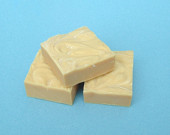We have many talented and creative people in the ICAN Community and beyond, and this month we’re going to highlight some of our favorites. We’re even having a contest for those of you out there who have designed and made your own awesome handmade items. Cooking, knitting, crafting… there are no limits to the creativity! Have you sculpted a placenta out of fondant? Have you knitted your midwife an umbilical cord scarf? Send your entries to education@ican-online.org with the subject line ICAN30Crafts and we’ll feature the best ones later in the month and on our Facebook page. The most “likes” will win a prize! Stay tuned!
Bloody Show, Sage Femme, Commemorative VBAC Bar?
Make Your Own Birth Themed Soaps for Cesarean Awareness Month!

Time to get your craft on just in time for Cesarean Awareness Month. If you’re like, me, you’ll need from now till April to get organized and get working! Birth themed soaps are fun to create and make a great gift for your favorite doula, midwife, ICAN leader or birthing friend. Birth themed soaps can be made in one of three ways:
Melt and Pour (M & P) Soapmaking:
Melt and pour soapmaking involves purchasing a ready made soap base like the one you have probably seen in your craft store and melting it, adding your own custom ingredients such as essential oils and colorants, then pouring it into the molds of your choice. Although M & P allows you to avoid working with lye, the vast majority of the bases sold have artificial additives (sorbitol anyone?) and so are something I personally avoid.
Cold Process or Hot Process Soapmaking:
Making natural soaps from scratch is not something to dabble in lightly since you will be working with lye which can cause burns both while you use it and in the finished product if you haven’t learned and applied appropriate soapmaking techniques. That said, if you are already an experienced soapmaker then below is a recipe you can try for making your own “Bloody Show” soap.
Rebatching or Hand-Milling Soaps:
Rebatching, also known as hand-milling, is when you take natural soap that has already been made then grate it, melt it, and add your own personal touches such as herbs, spices and essential oils. Other than avoiding the need to work with lye, the advantage of rebatching is that ingredients will not suffer through the harsh lye process and so more of their properties will remain intact in the finished bars. Rebatched soaps can be made from any plain, unscented natural bar soap such as Dr. Bronner’s Baby Mild, or you can buy freshly made, bulk soap from a natural soapmaker. Below are two recipes to get you started. For additional recipes ideas see Natural Soapmaking by Marie Browning.
“Bloody Show” Cold Process Soap
This recipe is for experienced cold process soap makers. Without the essential oil, the finished bars will be tan with orange undertones and smell simply like fresh soap. The blood orange juice increases the richness of the lather and brings the benefit of the fruit acids to your skin.
50 oz batch
25 oz coconut oil
7.5 oz palm oil
17.5 oz olive oil
17 oz blood orange juice
7.4 oz lye
blood orange essential oil (optional)
Make the blood orange juice by peeling the oranges, removing the seeds and running the flesh through a juice machine or hand juicing. Measure out the correct amount and freeze until slushy. Place frozen juice in your lye pitcher and add the lye very slowly, stopping frequently to stir. Once the lye is fully dissolved, proceed with soapmaking as normal. Do not insulate.
Rebatched, unscented “I Got My VBAC Commemorative Soap Bar”
unscented, grated cold process soap
distilled water
several natural colorants such as turmeric, paprika, spirulina (seaweed), ground safflower or saffron petals, ground dried herbs such as dill, parsley or sage
soap mold(s) such as a small cardboard box lined with a trash bag, plastic Gladware containers or empty pint containers like the ones that half and half come in.
Follow the instructions for melting rebatch soap found at Blue Aspen Originals http://www.blueaspenoriginals.org/how_to_rebatch.html Once your soap is melted, quickly remove several portions into individual bowls and add a small amount of one natural colorant to each portion. Stir well then spoon the colored portions back into your soap pot making sure to keep the colors separate. Use two large metal spoons to gently toss the different colored portions together as if tossing a salad. Do not over mix – you want the individual colors to be present in the finished bars. Glop the resulting mixture into your molds and tap them firmly on your counter in order to remove any air bubbles. Allow to cure for 1-3 days before unmolding and cutting and then air dry for 3 weeks before using.
Rebatched “Sage Femme” Soap
Follow the instructions above for “I Got My VBAC” soap but instead of adding colorants to portions of the melted soap, simply add a small amount of dried, ground sage to the pot. The sage itself will not scent the soap but you can add a small amount of sage essential oil if you’d like before putting the mixture into your molds.
Happy Soaping!
Barbara Stratton is our national ICAN VBAC ban chair as well as the co-leader of ICAN of Baltimore. Her unscented, natural, birth themed soaps and other body products can be found at baltimoresoaps.etsy.com.